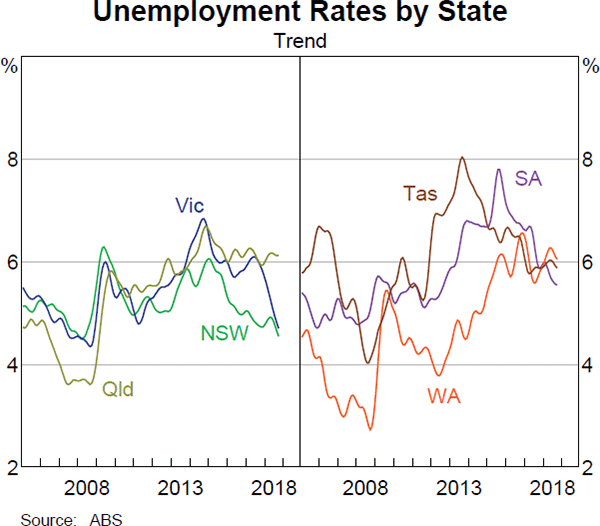Statement on Monetary Policy – November 2018 2. Domestic Economic Conditions
Domestic economic conditions have improved over the past year and continue to be supported by low interest rates and a strong global economy. GDP growth has picked up to its fastest year-ended rate since 2012, which was around the peak of the mining investment boom. The unemployment rate is at its lowest level since that time and overall labour market conditions remain positive.
Growth in economic activity has strengthened
Real GDP increased by 0.9 per cent in the June quarter and by 3.4 per cent over the year (Table 2.1; Graph 2.1). This is above estimates of potential growth, which implies that spare capacity in the economy is being absorbed. Growth was broadly based. Household consumption, dwelling investment, public demand and exports all contributed to growth in the quarter and over the year. Business investment also increased over the year, with strong growth in non-mining investment only partially offset by a decline in mining investment.
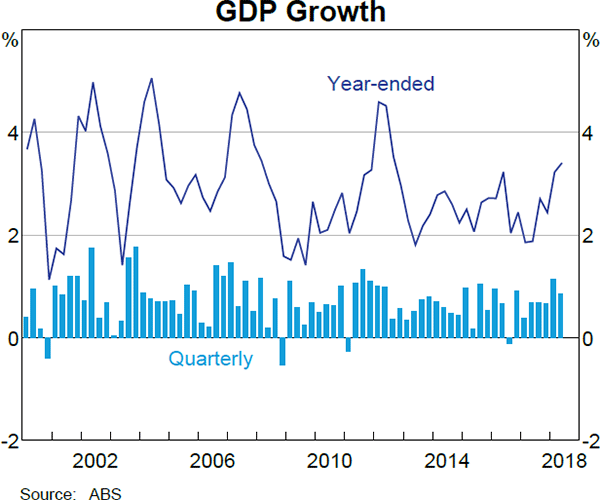
| June quarter 2018 |
March quarter 2018 |
Year to June quarter 2018 |
|
|---|---|---|---|
| GDP | 0.9 | 1.1 | 3.4 |
| Domestic final demand | 0.6 | 1.0 | 3.4 |
| – Consumption | 0.7 | 0.5 | 3.0 |
| – Dwelling investment | 1.7 | 3.6 | 3.8 |
| – Mining investment | 5.1 | −6.4 | −9.7 |
| – Non-mining investment | −1.7 | 2.8 | 8.8 |
| – Public consumption | 1.0 | 1.6 | 5.1 |
| – Public investment | −1.0 | 0.9 | 2.5 |
| Change in inventories(a) | 0.0 | 0.2 | 0.5 |
| Exports | 1.1 | 3.0 | 3.7 |
| Imports | 0.4 | 1.7 | 6.2 |
| Mining activity(b) | 2.0 | 3.3 | 8.3 |
| Non-mining activity(b) | 0.7 | 0.9 | 2.8 |
| Farm GDP | 1.1 | −0.5 | −9.7 |
| Non-farm GDP | 0.9 | 1.2 | 3.7 |
| Nominal GDP | 1.0 | 2.4 | 5.5 |
| Terms of trade | −1.3 | 3.5 | 2.1 |
|
(a) Contribution to GDP growth Sources: ABS; RBA |
|||
Household consumption growth has been resilient …
Household consumption growth has been stable at around 3 per cent over the past year or so (Graph 2.2). Goods consumption grew by 3.5 per cent over the year to the June quarter; strong growth in expenditure on food and clothing more than offset a decline in motor vehicle sales. Consumption of services grew by 2.6 per cent, supported by growth in the consumption of recreation and communication services.
There have been some sizeable upward revisions to consumption growth in recent quarters, notably to consumption of overseas travel services, which has become more complicated to measure after the discontinuation of outgoing passenger cards in mid 2017. By state, consumption growth continues to be strongest in New South Wales and Victoria (Graph 2.3).
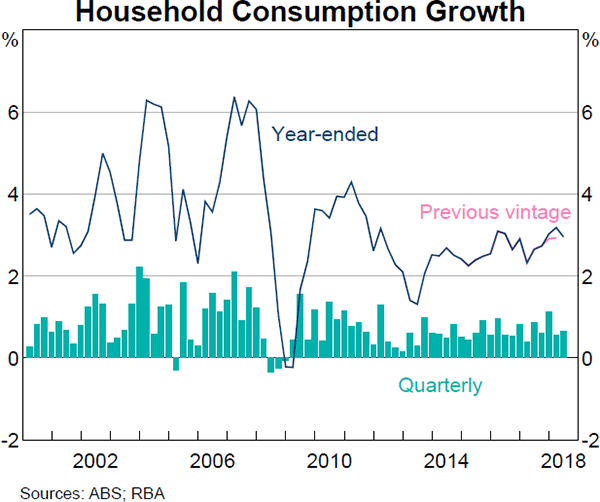
Indicators for the September quarter on balance point to continued steady growth in household consumption. Liaison with retailers suggests that underlying trading conditions have remained stable in recent months. Surveys suggest that household sentiment towards their own finances remains above average. The volume of retail sales increased by 0.2 per cent in the September quarter and were 2¼ per cent higher over the year (Graph 2.4). Online retail sales continued to grow strongly.
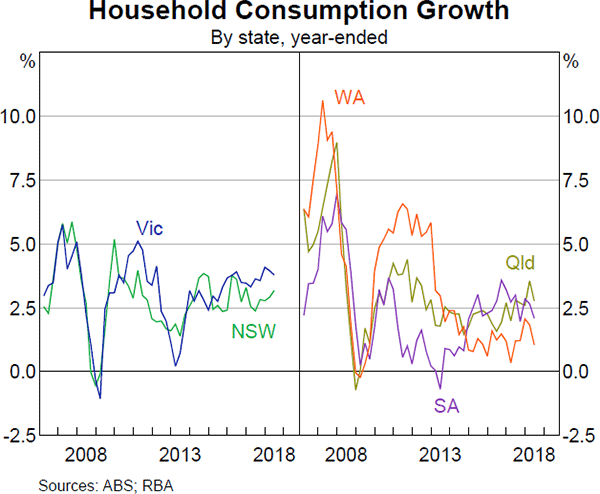
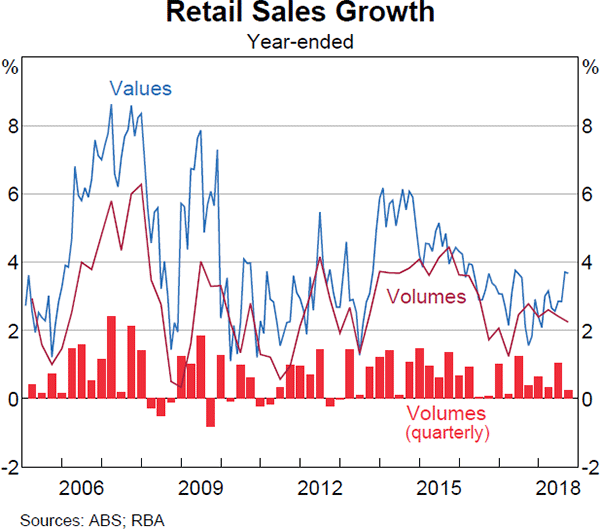
… despite the slow growth in household income
Growth in household income remains low, although it has picked up a little since early 2017 to around 3 per cent. This pick-up has been driven by labour income, which is growing at around its fastest year-ended rate since 2012, but is still below its long-run average (Graph 2.5). Growth in other sources of household income, such as social assistance payments, has remained weak. Income payable – which subtracts from disposable income – has increased, partly reflecting tax payments, which have grown more quickly than income. Meanwhile, recent declines in housing and equity prices will weigh on household wealth. In the recently released annual national accounts, household income was revised up over the past two years. This included upward revisions to gross mixed income and labour income, and downward revisions to payable transfers.
In recent years, consumption growth has been relatively resilient and has generally exceeded income growth: the household saving ratio has declined. The prospect of continued low growth in household income remains a risk to the outlook for household consumption, especially given high levels of household debt. In this respect, the recent pick-up in labour income growth has been a welcome development, and consumption growth is anticipated to remain relatively steady at current levels.
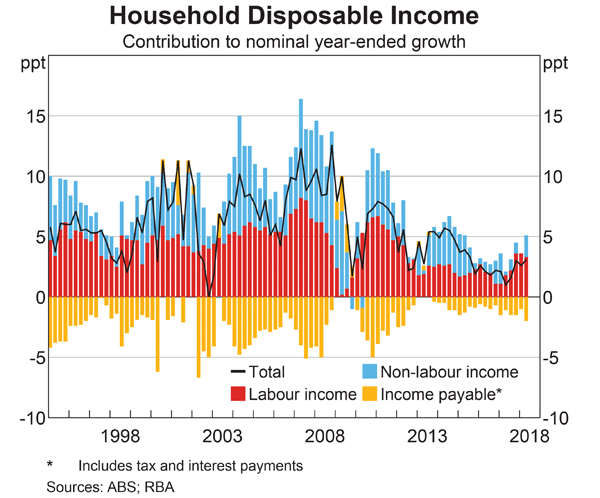
Non-mining business investment has grown strongly over recent years
Private non-mining business investment declined in the June quarter, but grew by 9 per cent over the year (Graph 2.6). This increase was led by non-residential construction activity, which includes non-residential building and infrastructure-related projects. Office construction was the largest driver of non-residential building investment. This is consistent with strong tenant demand in Sydney and Melbourne, and has occurred against a backdrop of relatively little new supply being added and some large withdrawals of stock in recent years. Construction of aged-care facilities as well as short-term accommodation also contributed to growth. Private sector spending on infrastructure-related projects also grew over the past year, led by electricity projects (including renewable energy), as well as road and water projects.
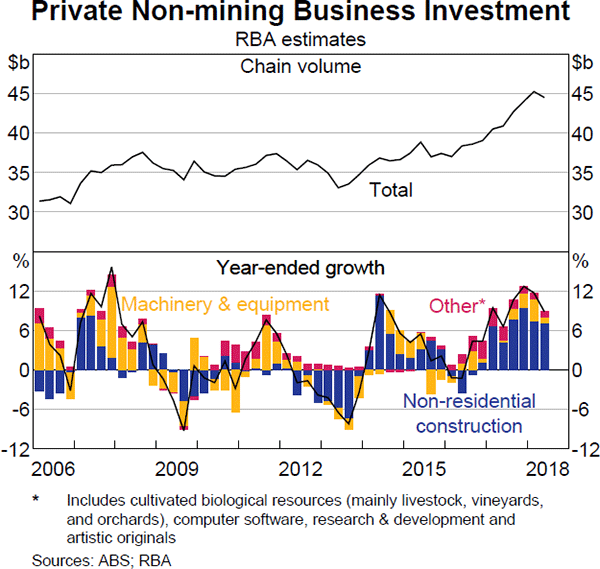
Leading indicators point to continued growth in non-mining business investment over the next year or so. The stock of work yet to be done on private buildings has increased over the past couple of years, and private non-residential building approvals have trended higher since the start of 2018, driven by approvals for office buildings in Sydney and Melbourne (Graph 2.7). Information from the Bank's liaison program suggests that tenant demand for new office space remains strong and is likely to support further expansions in office supply over the next couple of years. The pipeline of work yet to be done on private infrastructure projects has also risen over the past year or so, led mainly by road and electricity projects.
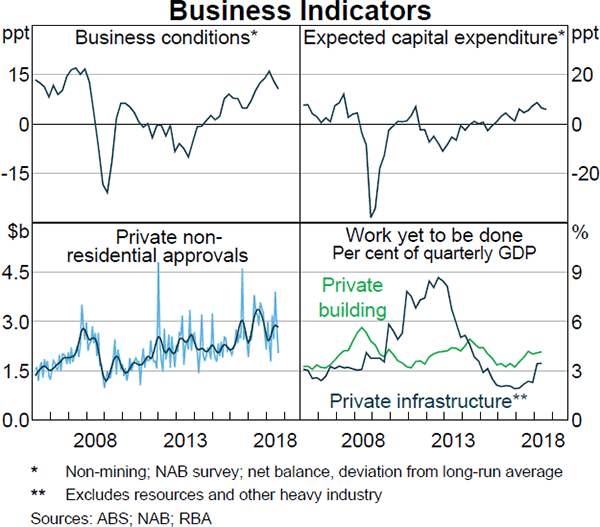
Profits have grown across many non-mining sectors over the past year, which should support firms' ability to finance new investments. Survey measures of business conditions and expected capital expenditure remain well above average, although both measures have eased a little since earlier in the year.
In contrast, the most recent Australian Bureau of Statistics (ABS) capital expenditure (Capex) survey is pointing to subdued outcomes for non-mining investment in 2018/19 (Graph 2.8). Expected spending was revised up for machinery & equipment, but revised down for buildings & structures. However, the Capex survey excludes some industries, and also some types of investment, such as investment in software, which liaison suggests remain an ongoing focus for many firms.
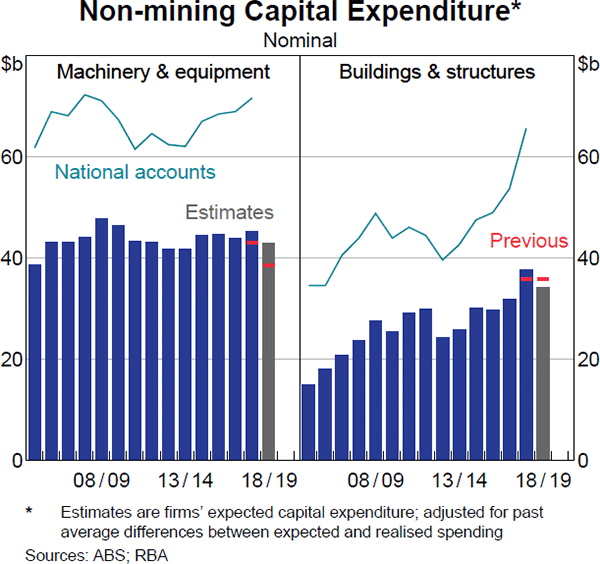
Public spending has been supporting growth
Public infrastructure work done remains high as a share of GDP (Graph 2.9). Work done on telecommunications projects has started to decline as the National Broadband Network gets closer to completion. However, work on transport projects has increased. The pipeline of work to be completed remains large and recent state and federal budgets also indicate that infrastructure spending will remain strong.
Public consumption grew by 5.1 per cent over the year to the June quarter. Recent data from the annual national accounts show that the recent strength in public consumption has been broad based at both the state and federal levels.
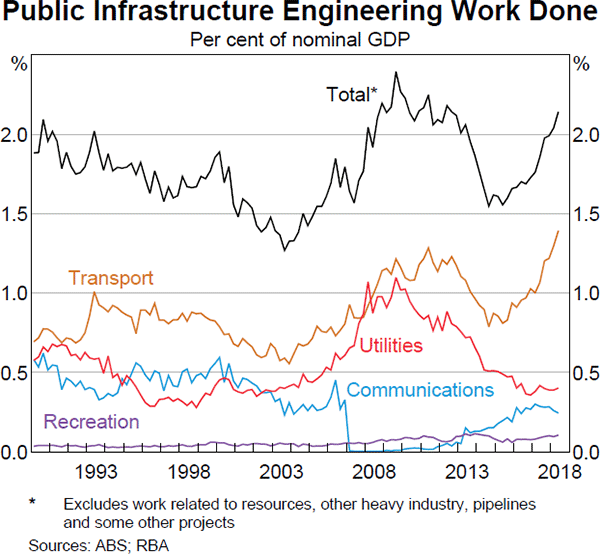
The final federal budget outcome for 2017/18 indicated that the underlying cash deficit was $10 billion or 0.6 per cent of GDP. This was $8 billion lower than expected in the May budget. Payments were $7 billion lower than projected, driven mainly by social security and welfare expenditure, while receipts were $1 billion dollars higher. The budget document indicated that lower payments relative to last year's forecasts were due in part to a slower uptake of the National Disability Insurance Scheme and lower expenses for aged pensions, family tax benefits and unemployment benefits (reflecting the impact of the increased retirement age and better economic conditions).
Mining sector investment is stabilising as LNG projects are completed
Mining investment grew strongly in the June quarter, but was 10 per cent lower over the year as construction on the remaining liquefied natural gas (LNG) projects continued to wind down (Graph 2.10). Some further decline in mining investment is expected over the coming quarters as these large LNG projects are completed, but cost overruns could mean that the overall decline in mining investment may be smaller than previously anticipated. Consistent with this, in the most recent Capex survey, expected spending on buildings & structures in 2018/19 was revised modestly higher.
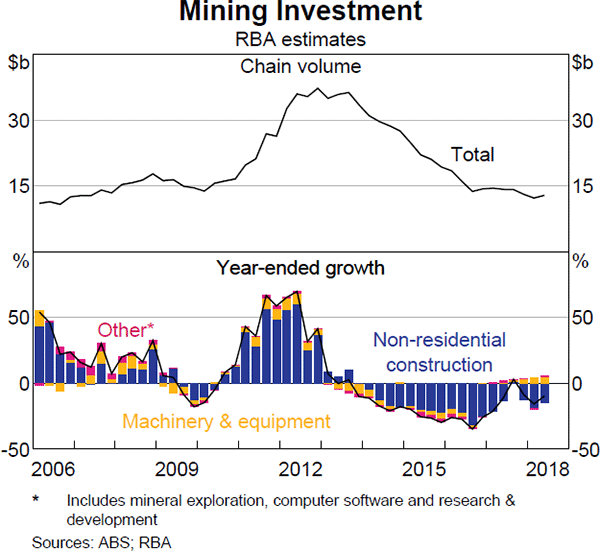
The Capex survey, information from the Bank's liaison program and company announcements indicate that mining firms have been increasing spending on machinery & equipment over the past year and further growth is anticipated over 2018/19. ABS data and liaison with firms also suggest that mineral exploration activity has picked up over the past year, in part in response to stronger commodity prices.
Drought conditions in some regions have affected rural output
Drought conditions have persisted in some regions since the beginning of the year, notably in New South Wales and bordering regions in other states. This has adversely affected some agricultural production. While conditions in Western Australia remain more favourable than those in the eastern states, frost in August and September has limited grain production in some parts of the state. Farm GDP and rural exports decreased by around 10 per cent over the year to the June quarter, partly reflecting unfavourable weather conditions and also a return to lower crop levels following the record winter crop harvest in 2016/17 (Graph 2.11).
Rural exports increased in the June quarter, driven by growth in exports of meat and other rural goods (Graph 2.12). Meat exports have continued to grow in recent quarters as producers have cut herd sizes because drought conditions have raised the costs of retaining livestock; solid overseas demand is helping to absorb the increase in supply. Growth in meat exports is expected to continue in the near term, while exports of cereal grains are expected to decline. If drier-than-average weather conditions persist, rural output (particularly crop production) is likely to fall further in coming quarters.
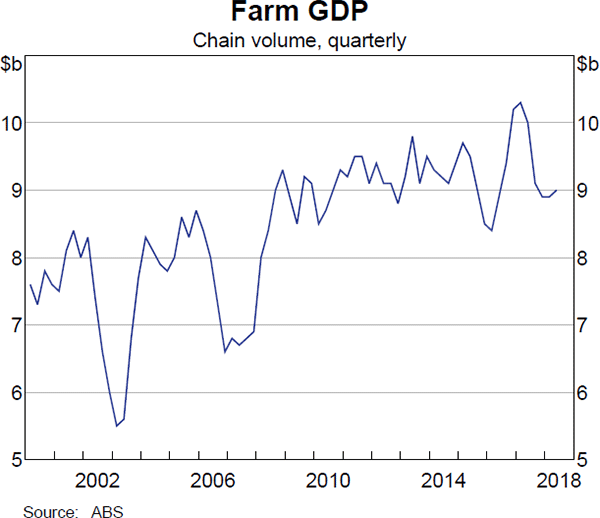
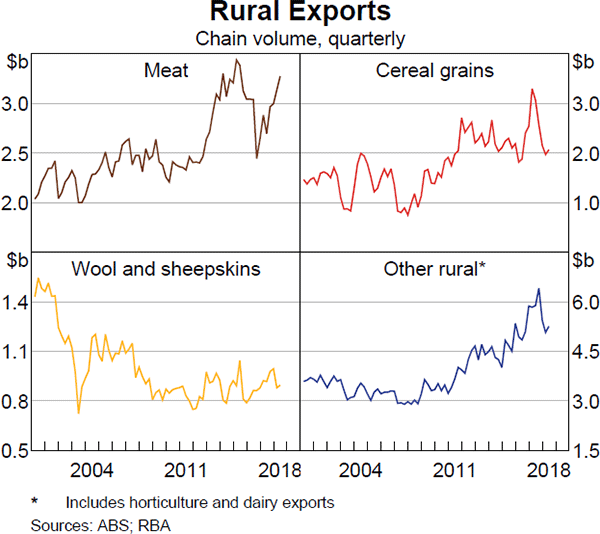
Export growth remains solid
Export volumes grew at a solid rate in the June quarter and the increase was broadly based. In addition to the increase in rural exports, resource exports rose modestly in the quarter. This was led by exports of iron and copper ore to China, and follows a strong increase in resource exports in the March quarter. LNG exports continue to grow steadily, while coal export volumes have remained around a high level for the past five years, notwithstanding quarter-to-quarter volatility (Graph 2.13).
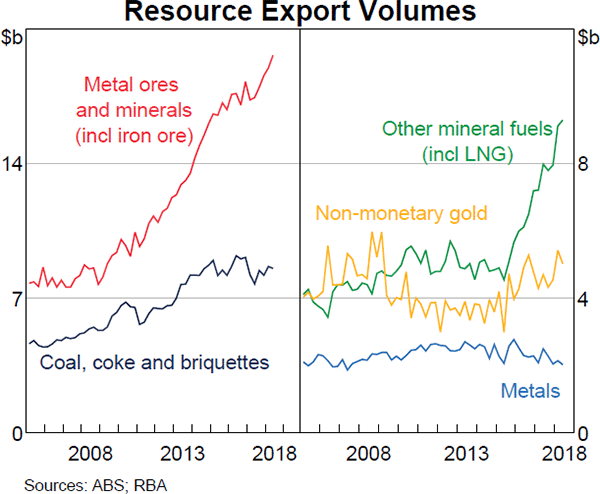
Resource exports have contributed materially to GDP growth over recent years as additional production capacity has come online. Further increases in resource exports are expected over the next year as production from the final LNG projects in Western Australia ramps up. Iron ore volumes are expected to increase a little further over the next few years, driven by productivity improvements from Australia's major producers. Other resource commodities are also expected to contribute modestly to GDP growth over the coming year as new projects are completed and existing mines increase production. Coal and iron ore exports are expected to be a little weaker in the near term, however, as maintenance and other disruptions affect supply.
Service and manufactured exports have grown steadily over recent years, supported by the continued economic expansion in Australia's major trading partners. Service exports are expected to remain a significant contributor to total export growth over the next couple of years. In particular, rising enrolments of overseas students in Australia are expected to support education exports.
Solid growth in domestic demand has been associated with steady growth in imports in recent quarters. Imports grew by 6 per cent over the past year, led by capital imports, consistent with the growth seen in business and public investment (which are relatively more import-intensive components of demand).
The increase in resource export volumes, together with increases in bulk commodity prices, saw the trade balance remain in surplus in the June quarter (Graph 2.14). This has offset some recent widening in the net income deficit, and has supported the current account deficit around its relatively low levels. The widening in the net income deficit over the past couple of years is consistent with a pick-up in dividend payments to non-residents as revenues in the (largely foreign-owned) mining sector have increased.
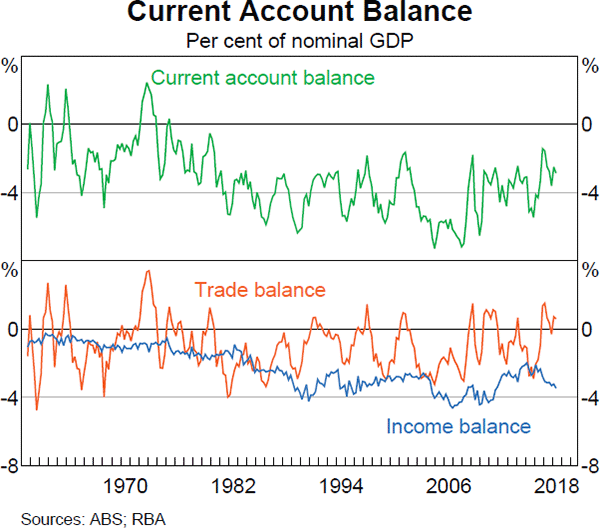
Dwelling investment is likely to be close to its peak
Dwelling investment rose by 1.7 per cent in the June quarter. Both detached and higher-density dwelling investment increased in the quarter and there were upward revisions to the level of dwelling investment in earlier quarters, lifting year-ended growth to 3.8 per cent. Growth was relatively broad based by state, but was particularly strong in New South Wales and Victoria, supported by unusually dry weather (Graph 2.15). Investment in alterations and additions declined in the quarter, driven by ongoing measured weakness in New South Wales.
Overall, it appears that dwelling investment is close to its peak in the current cycle. The number of private residential building approvals declined in the September quarter and were 11 per cent lower than a year ago. Liaison contacts continue to report that demand for new, off-the-plan apartments in Sydney and Melbourne has declined significantly since mid 2017, driven by a pull-back in demand from domestic investors and foreign buyers. Off-the-plan sales typically precede the issuance of a building approval, suggesting that higher-density residential approvals are likely to moderate further. Lot sales for new detached housing have also declined sharply in Sydney and Melbourne since late 2017, but were little changed in the June quarter (Graph 2.16).
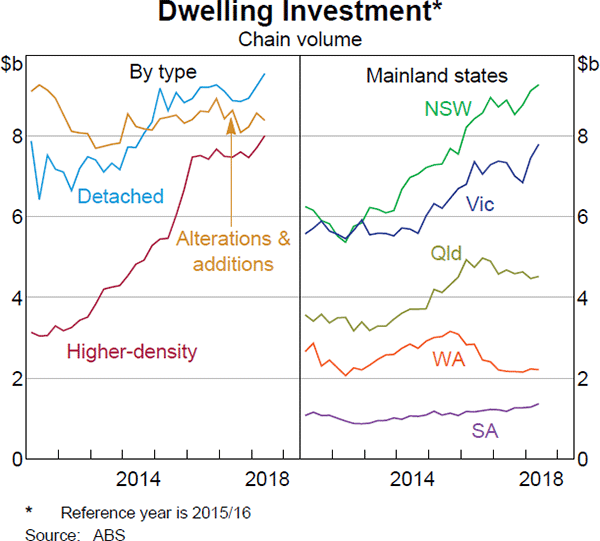
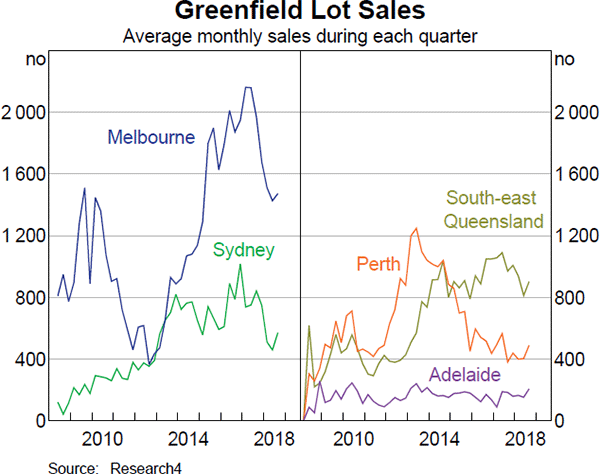
Despite the moderation in residential building approvals and pre-sales, dwelling investment is expected to remain at a high level for some time yet. The pipeline of work yet to be done was little changed in the June quarter, and should support a high level of dwelling investment for at least the next year (Graph 2.17). Part of the reason that the pipeline has increased in recent years is that there has been an increase in the average time between approval and commencement of higher-density dwellings, along with somewhat longer completion times. While the increase in commencement times could, in principle, indicate an increased risk that some projects could be abandoned, recently published ABS data indicate that the abandonment rate remained stable at around 2½ per cent of building approvals in 2017/18.
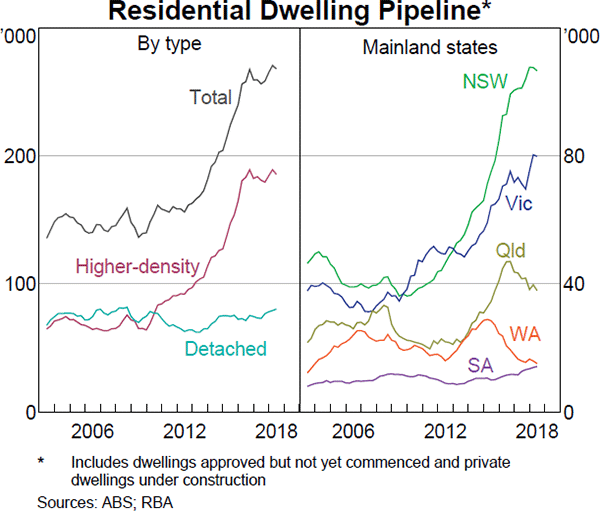
Housing prices have fallen in some cities after strong rises over previous years
Conditions in a number of the established housing markets have continued to ease gradually, including in Sydney and Melbourne. Nationally, established housing prices have declined by 4½ per cent since their September 2017 peak, following an increase of around 45 per cent over the previous five years. In Sydney, prices are around 8 per cent below their peak, while in Melbourne prices are around 5 per cent lower. In both cities, detached housing prices have declined by more than established apartment prices (Graph 2.18). Non-price indicators have also eased, with auction clearance rates and sales volumes falling and days on market increasing (Graph 2.19). In Perth, housing prices declined in the September quarter after stabilising somewhat in early 2018. Prices in other state capitals have been broadly stable of late.
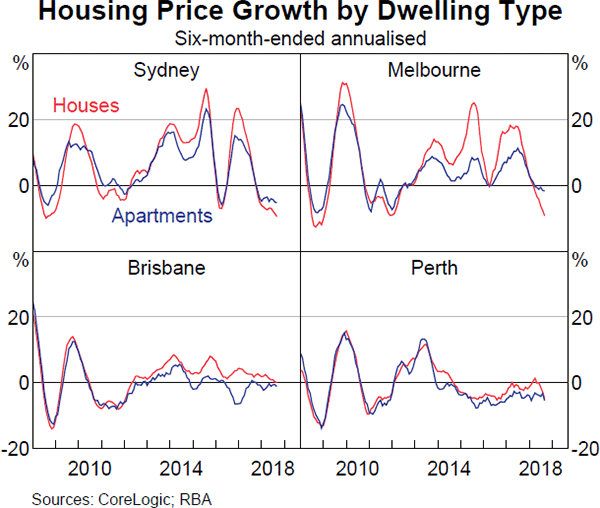
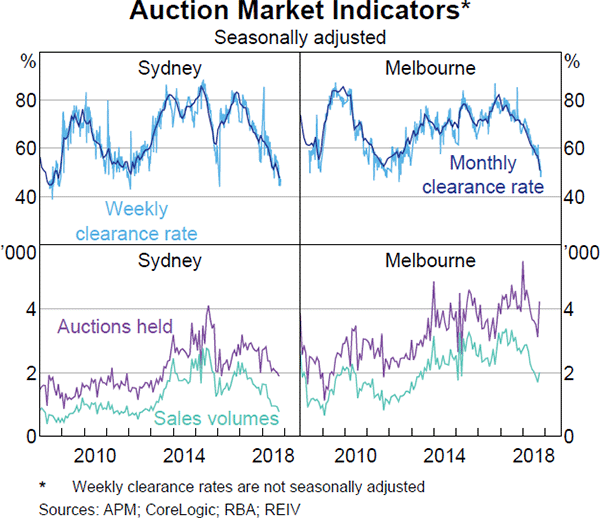
The easing of housing prices in Sydney and Melbourne reflects a range of factors. On the demand side, sentiment towards the housing market has become more cautious and this has been reflected in a slowing in demand for housing finance, particularly from investors (see ‘Domestic Financial Conditions’ chapter). The slowing in demand for investor housing credit has been reinforced by stricter lending conditions as a result of actions by regulators over the past few years, notably on investor, interest-only and high loan-to-valuation loans. Meanwhile, affordability constraints following several years of strong price growth and subdued income growth are also likely to have weighed on demand. Demand from foreign buyers has also declined, though this will have mainly affected demand for new properties, given restrictions on purchases of established dwellings by foreigners. The large supply of new dwellings is also likely to have weighed on housing prices and rents. That being said, population growth in Sydney and Melbourne has been supporting underlying demand for new dwellings in these cities, and is expected to continue to do so for some time yet.
In the rental market, vacancy rates are a little below average nationally and rent inflation is subdued (Graph 2.20). In Perth, rental vacancy rates have declined further and advertised rent inflation has stabilised following an extended period of falling rents. In Sydney, advertised rents have declined of late and the rental vacancy rate has crept up as new supply has come online. Meanwhile, in Melbourne, population growth continues to absorb the supply of new dwellings and so vacancy rates have declined.
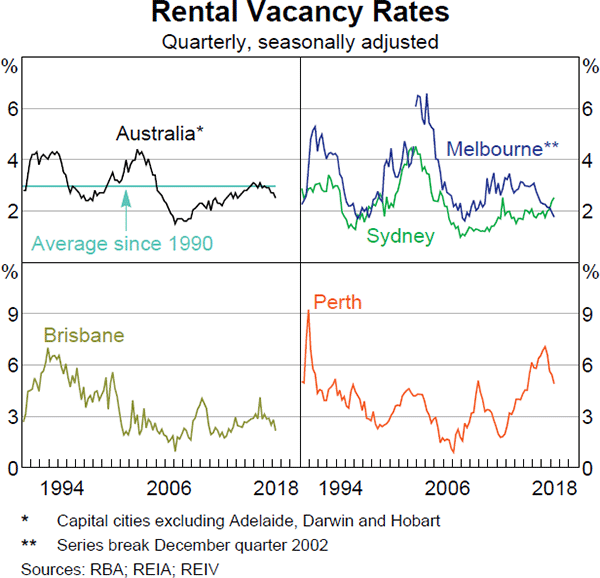
Employment has grown strongly over recent months
Employment grew by around 75,000 in the September quarter, to be 2¼ per cent higher over the year. This remains above growth in the working-age population and extends the recent period of strong employment growth since the start of 2017. Full-time employment accounted for most of the growth both in recent months and over the past two years (Graph 2.21). It is common for full-time employment growth to be relatively strong during periods of improvement in the labour market. Despite the recent strength in full-time employment growth, average hours worked have not risen; average hours worked by full-time workers have continued their long-standing downward trend. In contrast, the average hours worked by part-time workers have continued to increase gradually.
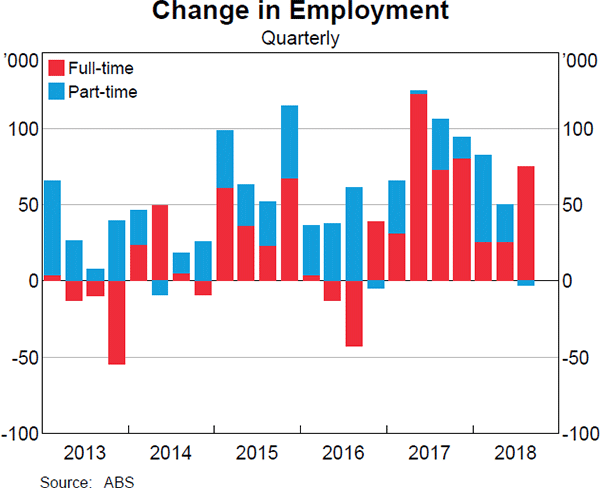
Much of the employment growth over the past year was in the manufacturing, construction and professional, scientific & technical industries (Graph 2.22). The increase in manufacturing employment is in line with the increase in manufacturing output over the past year; the industry has been supported by strong growth in export demand for food products, strong demand related to building activity in the eastern states, investment in defence and a modest increase in demand from the mining sector.
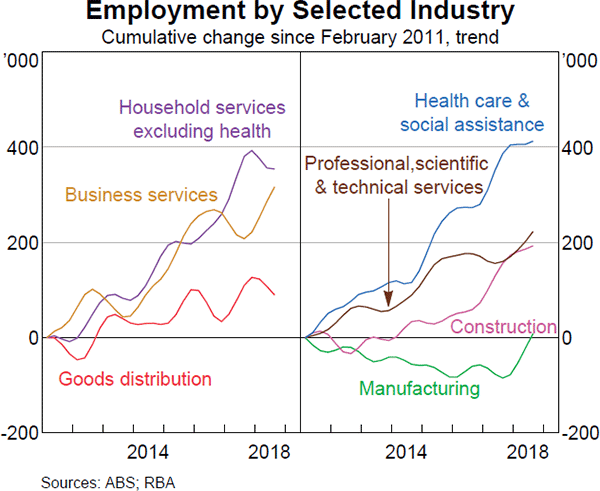
The increase in construction employment over the past year was concentrated in heavy and civil engineering, consistent with the elevated level of public infrastructure building activity. Employment in residential construction has declined a little recently but remains at a relatively high level.
The participation rate remained at a high level in the September quarter after rising sharply over 2017. The participation rates of males and females across most broad age categories have been little changed or declined a little this year. One exception is men over the age of 65, who have recorded a further increase in participation; this is likely to be related to the increase in the age of pension eligibility to 65½ years in mid 2017.
Overall, the labour demand indicators monitored by the Bank suggest that above-average growth in labour demand will continue over the remainder of this year (see ‘Box B: Indicators of Labour Demand’). Job vacancies as a share of the labour force remain at a very high level in New South Wales and Victoria, and have continued to increase sharply in Western Australia in recent quarters. Nationally, the ratio of job vacancies to unemployed persons has increased further over the past year, consistent with a decline in spare capacity in the labour market.
The unemployment rate has continued to decline, but some spare capacity remains
The unemployment rate fell to 5 per cent in September, from 5¼ per cent in the previous two months (Graph 2.23). While the labour force data can be volatile from month to month, the unemployment rate has declined by around ¾ percentage point since early 2017. A broader measure of labour market underutilisation – which captures the additional hours that underemployed people would like to work as well as hours sought by the unemployed – has also declined further over recent months.
There has been a notable decline in unemployment this year among those unemployed for between 13 weeks and one year (Graph 2.24). So far, there has been little reduction in the share of the labour force that has been unemployed for more than one year, but this measure of long-term unemployment should begin to decline noticeably if the labour market continues to improve as expected. The youth unemployment rate – defined here as the unemployment rate for 15–24 year olds – remains high but has declined sharply this year.
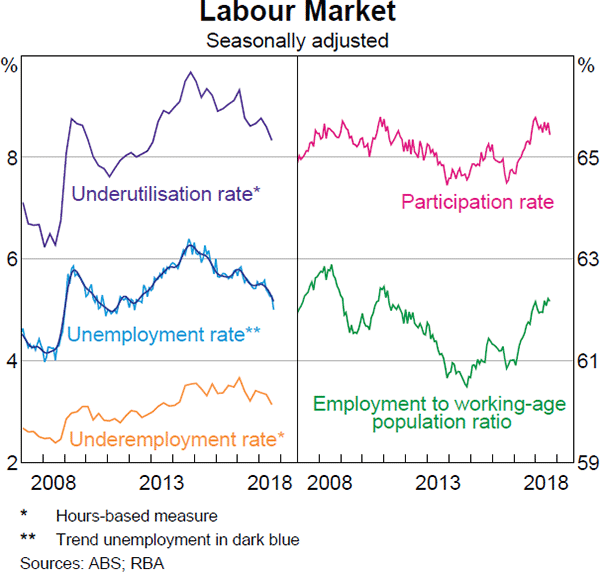
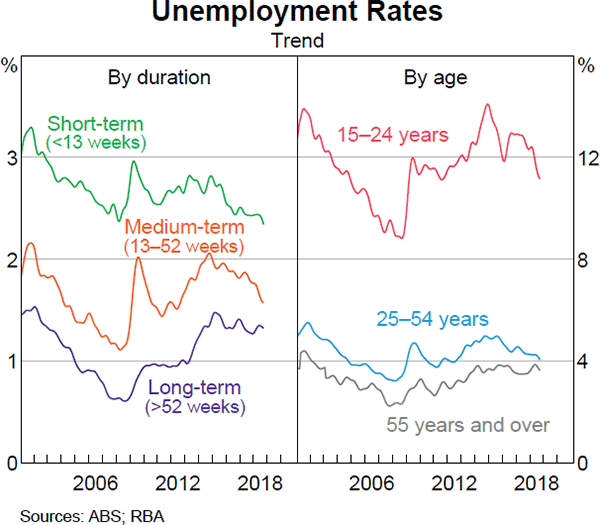
The unemployment rate in Victoria has declined by almost 1½ percentage points over the past year while the trend unemployment rates in South Australia and New South Wales have also declined a little in recent months (Graph 2.25). The unemployment rate in New South Wales is now at its lowest level in over a decade, and the state's participation rate is around its highest level in the series' history. Labour market conditions in Western Australia and Queensland appear to have stabilised in recent months, following a notable improvement last year.
